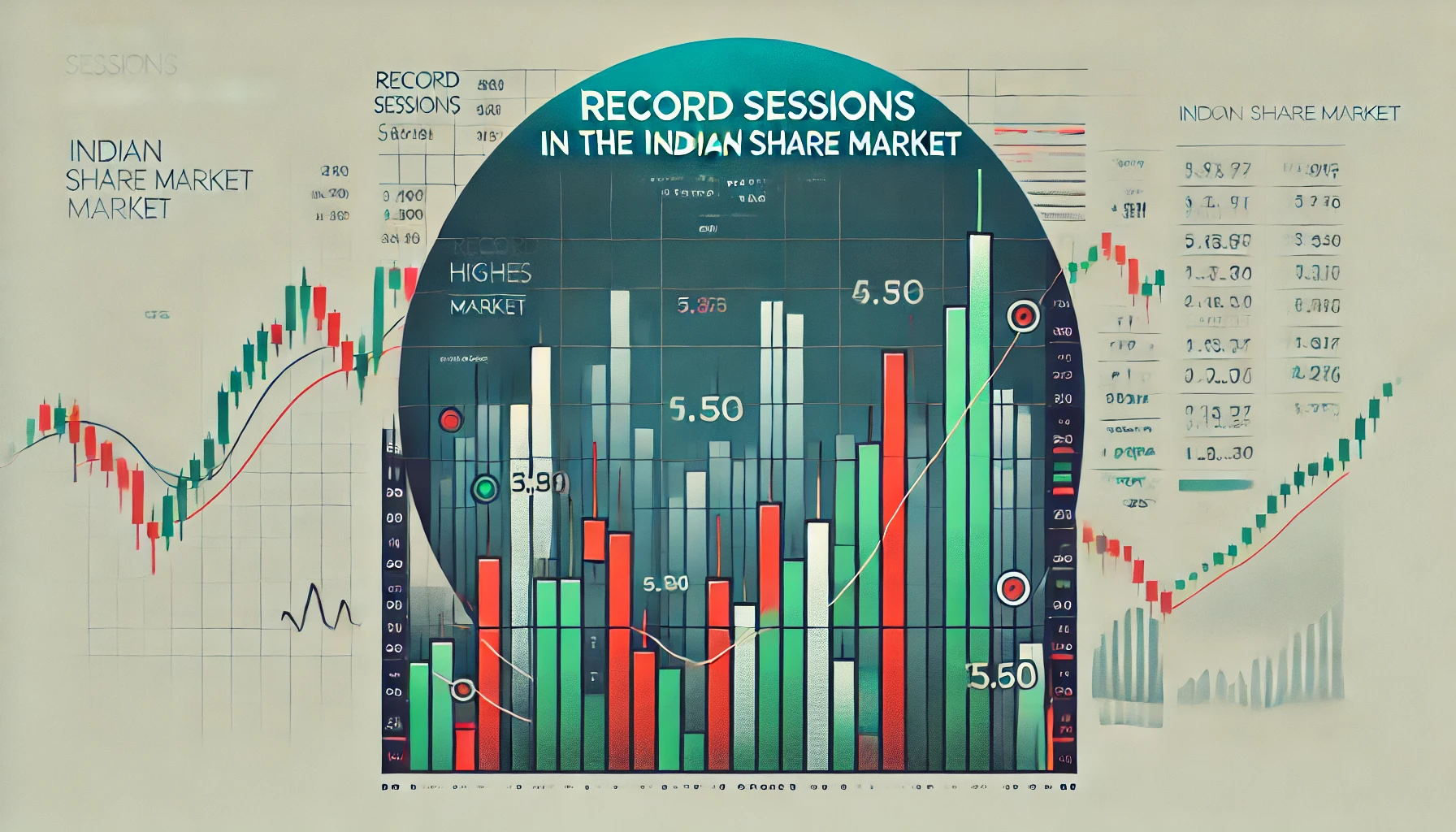The Indian share market, like any other, experiences constant fluctuations due to a multitude of factors. For traders, reading these movements and making informed decisions is crucial. Candlestick patterns are powerful tools used in technical analysis to predict market direction. One such pattern that signals indecision is the Spinning Top. This blog will discuss the Spinning Top candlestick, how it can be interpreted, and its historical importance in the Indian share market.
What is a Spinning Top Candlestick?
A Spinning Top is a candlestick pattern that shows indecision in the market. The Spinning Top has a small real body, with upper and lower wicks of almost equal length, indicating that both buyers and sellers were active during the session but were unable to establish control.
| Candlestick Characteristics | Spinning Top Pattern |
|---|---|
| Open Price ≠ Close Price | True |
| Small Real Body | True |
| Long Upper and Lower Wicks | Yes |
The pattern signifies indecision, where neither the bulls nor the bears are strong enough to take the market in a specific direction. The color of the body (whether green or red) is less significant, as the length of the shadows suggests volatility without a clear trend.
Types of Spinning Top Candlestick Patterns
There are a few variations of the Spinning Top pattern, each with slightly different implications.
- Bullish Spinning Top:
- This pattern occurs during a downtrend, signaling potential reversal. Buyers have started gaining control but are not yet fully dominant.
- Bearish Spinning Top:
- Found during an uptrend, the bearish Spinning Top suggests that sellers are beginning to exert influence but have not yet overwhelmed the buyers.
Both patterns are considered neutral, but their appearance often indicates that the current trend could soon change.
Interpreting Spinning Top in the Indian Share Market
In the context of the Indian share market, Spinning Top candlesticks often signal market indecision, followed by a potential trend reversal. Traders must analyze these candlesticks in relation to their position within a trend to understand their true significance.
- Spinning Top in an Uptrend: A Spinning Top during an uptrend indicates that buyers may be losing momentum, potentially leading to a trend reversal. Traders should be cautious and consider booking profits if they see this pattern after an extended rise.
- Spinning Top in a Downtrend: A Spinning Top in a downtrend suggests that sellers are losing strength, and the market may be primed for a bullish reversal. It’s often seen as a signal to enter the market with long positions.
Historical Data of Spinning Top in the Indian Share Market
Several historical examples from the Indian stock market illustrate how the Spinning Top has influenced stock price movements:
- Reliance Industries (2019): In November 2019, a Spinning Top appeared on the daily chart of Reliance Industries following a prolonged uptrend. This marked a period of consolidation, and the stock price reversed its course over the next few weeks, declining by approximately 8%.
- Tata Consultancy Services (2020): In May 2020, a Spinning Top formed after a significant decline in Tata Consultancy Services’ stock price. The pattern was followed by a strong bullish move, as the stock recovered more than 10% in the following month.
| Stock/Index | Date | Spinning Top Type | Resulting Trend |
|---|---|---|---|
| Reliance Industries | November 2019 | Bearish Spinning Top | Bearish Reversal (8%) |
| Tata Consultancy | May 2020 | Bullish Spinning Top | Bullish Reversal (10%) |
How to Trade Using Spinning Top in the Indian Share Market
While the Spinning Top signals indecision, it’s critical to use additional technical indicators to confirm the likelihood of a trend reversal or continuation. Here are some effective strategies:
- Spinning Top with Support and Resistance Levels: When a Spinning Top forms near significant support or resistance levels, it indicates the potential for a reversal. Traders can look for confirmation in the next few candles and make their decisions accordingly.
- Spinning Top with Volume Analysis: High trading volume during a Spinning Top formation often signals a stronger chance of reversal. Conversely, a low-volume Spinning Top may indicate that the market is consolidating rather than preparing for a reversal.
- Spinning Top with Moving Averages: The combination of Spinning Top patterns and moving averages can enhance a trader’s strategy. If a Spinning Top forms near a key moving average like the 50-day or 200-day moving average, it can signal a shift in market sentiment.
Limitations of the Spinning Top Pattern
Although the Spinning Top is a valuable tool in technical analysis, it is not a standalone indicator. It should be interpreted in conjunction with other indicators like trendlines, moving averages, and RSI.
- False Signals: The Spinning Top can give false signals, especially in highly volatile markets. Traders should be wary of entering trades based solely on this pattern.
- Unreliable in Consolidation Phases: During market consolidations, the Spinning Top often appears, but it may not lead to significant price changes.
Case Study: Spinning Top and Nifty 50
One of the most notable examples of the Spinning Top in the Indian market occurred in 2021. The Nifty 50 index showed a Spinning Top in February after a strong uptrend, followed by a consolidation phase. Traders who recognized the Spinning Top and paired it with RSI and moving averages were able to avoid losses by exiting positions.
| Date | Index | Trend Preceding Spinning Top | Post-Pattern Movement |
|---|---|---|---|
| February 2021 | Nifty 50 | Uptrend | Consolidation followed by a slight decline |
How to Use Spinning Top in Trading Strategies
To maximize the potential of the Spinning Top, traders should consider the following:
- Wait for Confirmation: It’s essential to wait for the next few candles to confirm the Spinning Top’s signal. If a bullish candle follows a bullish Spinning Top, it confirms the potential reversal. Similarly, a bearish candle following a bearish Spinning Top is confirmation of a downturn.
- Combine with Other Indicators: The most successful traders combine the Spinning Top with other indicators such as the RSI, Bollinger Bands, and Moving Averages. These additional indicators help filter out false signals.
- Set Stop-Loss Orders: Spinning Tops are often followed by volatile market movements. Setting a stop-loss order just below the low of a bullish Spinning Top or above the high of a bearish Spinning Top can help mitigate risk.
Conclusion:
The Spinning Top candlestick pattern is a powerful indicator of market indecision in the Indian share market. When combined with other technical indicators and observed in the context of the broader market trend, it can provide traders with valuable insights into potential reversals and entry/exit points. However, traders must exercise caution, as the Spinning Top is not a definitive signal of market direction on its own.
By understanding the characteristics and implications of the Spinning Top, traders in the Indian stock market can improve their decision-making process and enhance their chances of success.

What is the TRIN stock market indicator?
The TRIN (Trading Index), also referred to as the Arms Index, is a technical analysis …

Record Sessions
The Indian share market is a dynamic and volatile space where major highs and lows …

3 Line Strike
Candlestick patterns are a vital tool for traders in the stock market, offering insights into …

3 White Soldiers and 3 Black Crows
Candlestick patterns are a key element of technical analysis in stock trading, offering clear signals …

Gapping Doji
Candlestick patterns are a critical part of technical analysis in the stock market, providing traders …

3 Windows
Candlestick patterns are a vital part of technical analysis, offering traders and investors insights into …

2 Gapping Candles
In the fast-paced world of the Indian stock market, technical analysis plays a crucial role …

3 Inside Down and Up
Candlestick patterns are powerful tools in the world of technical analysis, offering traders insight into …

Bullish and Bearish Belt Hold
Technical analysis is an essential part of trading in the Indian share market. Candlestick patterns, …

Piercing and Dark Cloud Cover
In the ever-evolving Indian stock market, candlestick patterns are crucial for traders aiming to predict …

Double Doji
Candlestick patterns have long been a favored tool for technical traders to forecast market movements. …

Rising and Falling Windows
In the world of technical analysis, candlestick patterns are vital tools for traders to anticipate …

Tweezer Top and Bottom
In the fast-paced world of the Indian share market, traders use technical analysis tools to …

Morning Star and Evening Star
In the Indian share market, technical analysis is a valuable tool for traders aiming to …

Hammer and Hanging Man
The Indian stock market offers a wealth of opportunities for traders who understand technical analysis. …

Shooting Star and Inverted Hammer
The Indian stock market, with its dynamic nature, presents various opportunities for traders and investors. …

Last Engulfing
The Indian share market is filled with patterns that can help traders make informed decisions. …

Harami
In the world of stock market analysis, candlestick patterns offer valuable insights into price movements. …

Engulfing
The Indian share market is known for its volatility, and traders often rely on technical …

Marubozu
Candlestick patterns are powerful tools used by traders in the Indian share market to analyze …

Spinning Top
The Indian share market, like any other, experiences constant fluctuations due to a multitude of …

Doji
The Indian share market is dynamic, with investors using various tools to gauge stock performance. …

Double Top
In the world of technical analysis, chart patterns are valuable tools that help traders spot …

Tweezer
In the Indian share market, where volatility and price fluctuations are part of daily trading, …

Harami
In the world of technical analysis, candlestick patterns are powerful tools that help traders make …

Heiken-Ashi
Navigating the Indian share market can be challenging due to the inherent volatility and market …

Ichimoku
In the world of technical analysis, few indicators offer the comprehensive insights that the Ichimoku …

Value Charts
In the ever-changing landscape of the Indian share market, traders and investors need tools that …

Money Flow Index
In the Indian share market, identifying trends, understanding momentum, and assessing volume are critical components …

Aroon
In the fast-paced world of the Indian share market, identifying market trends and spotting reversals …

Gator Indicator
In the Indian share market, success is largely dependent on identifying the right trends and …

Adaptive Moving Average
In the dynamic and often volatile Indian share market, traders and investors continuously seek tools …

Coppock Curve
In the ever-evolving landscape of the Indian share market, traders and investors rely on technical …

Premier Stochastic Oscillator
In the fast-paced world of the Indian share market, technical indicators are indispensable tools that …

Dynamic RSI
The Indian share market is known for its volatility, with frequent shifts in trends influenced …

Vortex
The Indian share market offers plenty of opportunities for traders and investors to capitalize on …

Glitch Index
The Indian share market, like all financial markets, is prone to moments of irregular behavior—unexpected …

Triple Exponential Average
Navigating the Indian share market requires traders to use effective tools that help them track …

Know Sure Thing
The Indian share market presents countless opportunities for traders and investors, but making accurate decisions …

Mass Index
The Indian share market is volatile, with price trends constantly shifting due to numerous factors. …


















